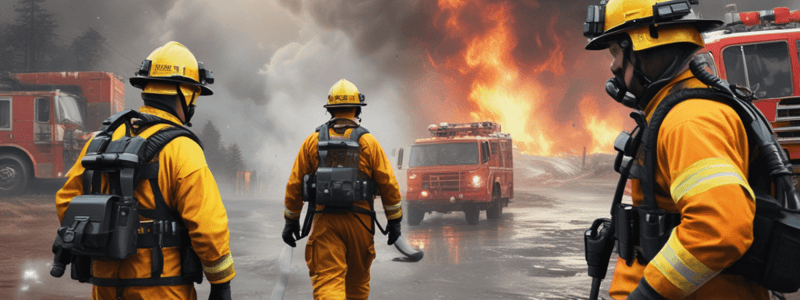Podcast
Questions and Answers
According to protocol, what should be done if the owner's lockout/tag-out equipment is not available?
According to protocol, what should be done if the owner's lockout/tag-out equipment is not available?
- Assign a team member to manually shut off the energy source
- Utilize the Fire Department's lockout/tag-out equipment whenever possible (correct)
- Use the Fire Department's equipment as a last resort
- Proceed without lockout/tag-out equipment
When should the Fire Department's lockout/tag-out equipment not be used?
When should the Fire Department's lockout/tag-out equipment not be used?
- When the owner's equipment is not available
- Never, it should always be used (correct)
- When the energy source can be safely isolated
- When the equipment is available and can be used safely
What is the purpose of assigning a Fire Department member to manually shut off the energy source?
What is the purpose of assigning a Fire Department member to manually shut off the energy source?
- To assist in the rescue operation
- To provide additional scene safety
- To ensure the energy source remains in the 'on' position
- To safeguard that the energy source remains in the 'off' position (correct)
When can the energy source not be safely isolated?
When can the energy source not be safely isolated?
What should be done with the lockout/tag-out equipment found in the kits?
What should be done with the lockout/tag-out equipment found in the kits?
What is required when the energy source cannot be safely isolated?
What is required when the energy source cannot be safely isolated?
According to the document, when is it considered necessary to isolate energy sources during rescue operations?
According to the document, when is it considered necessary to isolate energy sources during rescue operations?
Flashcards are hidden until you start studying
Study Notes
Lockout/Tag-out and Isolation of Hazards During Rescue Operations
Purpose
- Lockout/Tag-out is the preferred method of isolating machines, equipment, or areas from energy sources during rescue operations.
Policy
- Energy sources must be isolated (controlled or shut down) before a rescue can safely take place in situations such as:
- Machines or equipment involved in a rescue
- Areas directly exposed to energy sources (e.g., elevators, confined spaces, utility/telephone poles, electrically-powered conveyor systems)
Procedure
- Consult the owner or user of the machine, equipment, or area before initiating lockout/tag-out operations
- Utilize the owner's or user's lockout/tag-out equipment and practices whenever possible
- Use the Fire Department's lockout/tag-out equipment (carried on each engine) if the owner's equipment is not available or cannot be used safely
- Use the equipment according to the manufacturer's instructions
- Assign a Fire Department member to manually shut off the energy source and remain at the shut-off location if lockout/tag-out equipment cannot be used
- Maintain a higher level of rescue accountability and scene safety if the energy source cannot be safely isolated (e.g., sanitary or storm sewer)
Studying That Suits You
Use AI to generate personalized quizzes and flashcards to suit your learning preferences.




